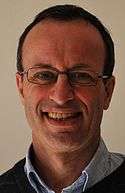Steven T. Bramwell
Steven T. Bramwell (born 7 June 1961) is a British physicist and chemist who works at the London Centre for Nanotechnology and the Department of Physics and Astronomy, University College London. He is known for his experimental discovery of spin ice with M. J. Harris and his calculation of a critical exponent observed in two-dimensional magnets with P. C. W. Holdsworth. A probability distribution for global quantities in complex systems, the "Bramwell-Holdsworth-Pinton (BHP) distribution", (to be implemented in Mathematica[3]) is named after him.[4]
Steven T. Bramwell | |
|---|---|
 | |
| Born | 7 June 1961 |
| Nationality | British |
| Alma mater | Oxford University |
| Known for | spin ice, magnetic monopole, magnetricity, BHP distribution |
| Awards | Holweck Prize (2010)[1] Europhysics Prize (2012)[2] |
| Scientific career | |
| Fields | physics and chemistry |
| Institutions | London Centre for Nanotechnology, University College London |
| Website | www |
In 2009 Bramwell's group was one of several to report experimental evidence of magnetic monopole excitations in spin ice. He coined the term "magnetricity" to describe currents of these effective magnetic "monopoles" in condensed-matter systems.[5]
Bramwell studied chemistry at Oxford University, obtaining his PhD in 1989. He was a professor of physical chemistry at University College London from 2000-2009, before becoming a Professor in the Department of Physics and Astronomy.
Honours and distinctions
Bramwell was awarded the 2010 Holweck Prize of the British Institute of Physics and the Société Française de Physique (SFP) for "pioneering new concepts in the experimental and theoretical study of spin systems".[1] He shared the 2012 Europhysics Prize of the European Physical Society Condensed Matter Division "for the prediction and experimental observation of magnetic monopoles in spin ice".[2] He is a Fellow of the Institute of Physics.
In 2010 he won the Times Higher Education research project of the year for "magnetricity",[6] and was named by The Times on their list of the 100 top UK scientists.[7]
Selected publications
- Harris, M.; Bramwell, S.; McMorrow, D.; Zeiske, T.; Godfrey, K. (1997). "Geometrical Frustration in the Ferromagnetic Pyrochlore Ho2Ti2O7" (PDF). Physical Review Letters. 79 (13): 2554–2557. Bibcode:1997PhRvL..79.2554H. doi:10.1103/PhysRevLett.79.2554.
- Bramwell, S T; Harris, M J (13 April 1998). "Frustration in Ising-type spin models on the pyrochlore lattice". Journal of Physics: Condensed Matter. 10 (14): L215–L220. Bibcode:1998JPCM...10L.215B. doi:10.1088/0953-8984/10/14/002.
- Bramwell, S. T. (16 November 2001). "Spin Ice State in Frustrated Magnetic Pyrochlore Materials". Science. 294 (5546): 1495–1501. arXiv:cond-mat/0201427. Bibcode:2001Sci...294.1495B. doi:10.1126/science.1064761. PMID 11711667.
- Bramwell, S T; Holdsworth, P C W (25 January 1993). "Magnetization and universal sub-critical behaviour in two-dimensional XY magnets". Journal of Physics: Condensed Matter. 5 (4): L53–L59. Bibcode:1993JPCM....5L..53B. doi:10.1088/0953-8984/5/4/004.
- Holdsworth, P. C. W.; Bramwell, S. T.; Pinton, J.-F. (10 December 1998). "Universality of rare fluctuations in turbulence and critical phenomena". Nature. 396 (6711): 552–554. Bibcode:1998Natur.396..552B. doi:10.1038/25083.
- Bramwell, S.; Christensen, K.; Fortin, J.-Y.; Holdsworth, P.; Jensen, H.; Lise, S.; López, J.; Nicodemi, M.; Pinton, J.-F.; Sellitto, M. (2000). "Universal Fluctuations in Correlated Systems". Physical Review Letters. 84 (17): 3744–3747. arXiv:cond-mat/9912255. Bibcode:2000PhRvL..84.3744B. doi:10.1103/PhysRevLett.84.3744.
- Fennell, T.; Deen, P. P.; Wildes, A. R.; Schmalzl, K.; Prabhakaran, D.; Boothroyd, A. T.; Aldus, R. J.; McMorrow, D. F.; Bramwell, S. T. (3 September 2009). "Magnetic Coulomb Phase in the Spin Ice Ho2Ti2O7". Science. 326 (5951): 415–417. arXiv:0907.0954. Bibcode:2009Sci...326..415F. doi:10.1126/science.1177582.
- Bramwell, S. T.; Giblin, S. R.; Calder, S.; Aldus, R.; Prabhakaran, D.; Fennell, T. (15 October 2009). "Measurement of the charge and current of magnetic monopoles in spin ice". Nature. 461 (7266): 956–959. arXiv:0907.0956. Bibcode:2009Natur.461..956B. doi:10.1038/nature08500. PMID 19829376.
References
- "2010 Holweck medal and prize". iop.org. Retrieved March 23, 2013.
- "EPS CMD Europhysics Prize". epsnews.eu. June 28, 2012. Retrieved March 23, 2013.
- Trott, Michael; Marichev, Oleg (February 1, 2013). "The Ultimate Univariate Probability Distribution Explorer". blog.wolfram.com. Retrieved March 23, 2013.
- Crooks, Gavin E. "Survey of simple, continuous, univariate probability distributions" (PDF).
- Powell, Devin (February 14, 2011). "'Magnetricity' Created in Crystals of Spin Ice". wired.com. Retrieved March 23, 2013.
- "EPSRC researchers win 'Research project of the year' at the Times Higher Education Awards". epsrc.ac.uk. November 30, 2010. Archived from the original on July 15, 2012. Retrieved March 23, 2013.
- Durrani, Matin (Oct 7, 2010). "100 top UK scientists revealed". blog.physicsworld.com. Retrieved March 23, 2013.
External links
- Steve Bramwell | London Centre for Nanotechnology
- Survey of two dimensional critical exponents by Taroni, Bramwell and Holdsworth
- Mini-lecture: Professor Steve Bramwell on 'magnetricity' (UCL) on YouTube
- Spin ice monopole creation and magnetricity on YouTube
- Steve Bramwell discusses Marie and Pierre Curie on Radio 4’s In Our Time